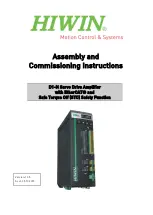
MMP SA-2550A
Page 22 of
24
Midwest Motion Products
DESIGN, MANUFACTURING & DISTRIBUTION - MOTION CONTROL EQUIPMENT
email:
2.
How to perform current loop tuning on the SA-2550A
The servo amplifier has already been configured to handle the majority of motors. The following are indications that current loop
tuning may be necessary:
-
Motor rapidly overheats even at low current
-
Drive rapidly overheats even at low current
-
Vibration sound comes from the drive or motor
-
The motor has a high inductance (+10mH)
-
The motor has a low inductance (near minimum rating of the drive)
-
Slow system response times
-
Excessive torque ripple
-
Difficulty tuning position or velocity loops
-
Electrical noise problems
-
High power supply voltage (power supply is significantly higher than the motor voltage rating or near the drive’s upper voltage
limit)
-
Low power supply voltage (power supply voltage is near the drive’s lower voltage limit)
To perform current loop tuning, first locate the relevant potentiometer (POT 1) as shown below:
Figure 5. Location of current loop tuning potentiometer on SA-2550A Servo Amplifier.
Note: If you are running in current mode then current loop tuning is not necessary; the instructions below only apply while
in velocity mode. turn the loop gain potentiometer full CCW (low).
To tune the servo amplifier, follow these steps:
1.
Connect the motor with the load attached.
2.
Start the motor with load.
3.
Turn the current loop tuning potentiometer clockwise until the motor begins to make audible noise.
WARNING: Exercise extreme caution when turning the potentiometer as it is very fragile. It is recommended to use a bent,
z-shaped wire in place of a flat screw driver to minimize the possibility of damage.
4.
Turn the current loop tuning potentiometer counterclockwise slowly until the noise subsides.
MIDWEST M
O
TION
P
RODUCTS



































